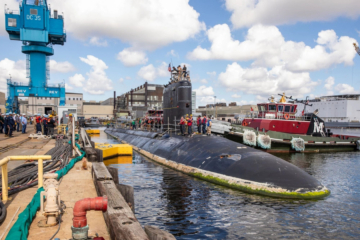Purple crabs clobber blue carbon
The following story originally appeared on the website for William & Mary’s Batten School & VIMS. – Ed.
Millions of purple marsh crabs are churning through salt marshes along the East Coast, significantly disrupting the storage of carbon within these ecosystems.
The small crabs’ constant burrowing and consumption of the cordgrass lead to erosion and a 40-70% loss in carbon, according to the results of a study by a team of marine ecologists and coastal geologists at William & Mary’s Batten School & VIMS.
Serina Wittyngham led the study as a postdoctoral researcher working in the lab of coauthor Matt Kirwan, coastal geologist and professor at the Batten School & VIMS. She notes that blue carbon, or carbon captured by oceans and coastal systems, is considered an important factor in meeting future climate goals. However, the impact of animals on carbon cycling in coastal ecosystems is not well documented.
“Most researchers who study blue carbon cycling stop at the plants, but we asked, ‘what about the creatures removing the plants?’” said Wittyngham, who leaned on the marine ecology expertise she gained while earning her Ph.D. at the Batten School of Coastal & Marine Sciences under the guidance of academic advisor and study coauthor David Samuel Johnson. “Part of what made this study unique was how we combined the expertise of the coauthors to look at carbon cycling in a way that hadn’t been fully considered before.”

The impact of the small invertebrates on salt marshes is visually dramatic and can be seen in satellite imagery. Known as consumer fronts, the grazing crabs leave expansive, fan-shaped mudflats as they burrow into the marsh and consume large swaths of cordgrass.
The researchers identified consumer fronts in Virginia, South Carolina and Georgia, evaluating four distinct sites in each state. They measured carbon loss, gain and recovery by calculating the aboveground biomass of the plants and taking 30cm-deep core samples of sediment in disturbed and undisturbed areas.
The scientists also used a remote sensing technique developed by coauthor and former Batten School & VIMS Postdoctoral Researcher Yaping Chen to track the long-term movements of the crabs. Chen identified 50 additional consumer fronts using high-resolution aerial images taken between 1993-2019.
The team found that all three states experienced a net loss in carbon stocks when comparing ungrazed and recovering areas. Estimated times for carbon recovery varied significantly between states. Salt marshes in South Carolina were estimated to take approximately five years to recover their carbon losses, while Georgia marshes recovered in 17 years and Virginia marshes may never regain their lost carbon. The remote sensing data showed that the rates of consumer front movement are accelerating, with an approximately 30% increase in their formation and movement since the early 1990s.
The different recovery periods are thought to be caused by the elevation of the salt marsh and the amount of water that moves in and out during a tidal cycle. Salt marshes in locations featuring higher elevations and greater water inundation better facilitate the growth of cordgrass.

“What’s happening is that the crabs are lowering the elevation of the marsh through sediment loss as they burrow and consume the grass. This causes more water to flood the marsh, which is good for the grass but causes the crabs to move to higher ground,” said Johnson.
“Our findings are a great example of why, when possible, science must account for regional variability when considering the impacts of various factors on ecosystems,” said Wittyngham. “Additionally, salt marshes are incredibly resilient and an exciting takeaway from our study is that the marshes themselves always recovered. Whether or not they regained their lost carbon, the plants always grew back.”
The full manuscript of the study is available online.
Latest W&M News
- It’s that time of year — not just for holiday cheer, for the fluKurt Williamson, William & Mary associate professor of biology, discusses the virus and hypotheses for why infections spike in the fall and winter.
- William & Mary to be the US academic home of submarine productionWilliam & Mary will soon host one of just three centers in the world to support submarine production through the Australia, United Kingdom and United States (AUKUS) security alliance.
- Kerry upholds science, research-backed truth as inaugural Blue Horizons FellowThe new program brings leaders, innovators to William & Mary’s Batten School & VIMS to inspire, engage and collaborate.
- National TRAP Program targets ghostly issue with second round of coastal clean up fundingThe second round of programmatic funding awarded by William & Mary’s Batten School & VIMS totals $1.8M in support of 13 projects focused on removing derelict fishing gear from coastal waters.
- Wiley makes her voice heard — through audiobooksStudents who pursue theatre degrees may find a foothold in a field that's booming: audiobook narration.
- W&M’s cross-university environmental initiative hosts inaugural conferenceThe Virginia Coastal Resilience Collaborative brought together prominent perspectives on important state and local issues.












